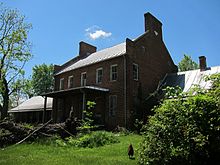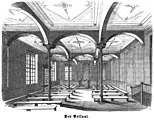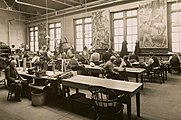| This article needs additional citations for verification. Please help improve this article by adding citations to reliable sources. Unsourced material may be challenged and removed. Find sources: "Poorhouse" – news · newspapers · books · scholar · JSTOR (March 2011) (Learn how and when to remove this message) |
A poorhouse or workhouse is a government-run (usually by a county or municipality) facility to support and provide housing for the dependent or needy.
Workhouses

In England, Wales and Ireland (but not in Scotland), "workhouse" has been the more common term. Before the introduction of the Poor Laws, each parish would maintain its own workhouse; often these would be simple farms with the occupants dividing their time between working the farm and being employed on maintaining local roads and other parish works. An example of one such is Strand House in East Sussex. In the early Victorian era (see Poor Law), poverty was seen as a dishonourable state. As depicted by Charles Dickens, a workhouse could resemble a reformatory, often housing whole families, or a penal labour regime giving manual work to the indigent and subjecting them to physical punishment. At many workhouses, men and women were split up with no communication between them. Furthermore, these workhouse systems were instituted under the Poor Law Amendment Act 1834: The United Kingdom passed this act to attempt to cut expenditure on those in poverty, reduce the number of beggars on the street, and inspire lower-class people to work harder in order to better provide for themselves.
Poor farms

United States
In the United States, poorhouses were most common during the 19th and early 20th centuries. They were often situated on the grounds of a poor farm on which able-bodied residents were required to work. A poorhouse could even be part of the same economic complex as a prison farm and other penal or charitable public institutions. Poor farms were county- or town-run residences where paupers (mainly elderly and disabled people) were supported at public expense. They were generally under the direction of one or more elected or appointed "Superintendent of the Poor."
Most were working farms that produced at least some of the produce, grain, and livestock they consumed. Residents were expected to provide labor to the extent that their health would allow, both in the fields and in providing housekeeping and care for other residents. Rules were strict and accommodations minimal.
Poor farms were based on the U.S. tradition of county governments (rather than cities, townships, or state or federal governments) providing social services for the needy within their borders. Following the 1854 veto of the Bill for the Benefit of the Indigent Insane by Franklin Pierce, the federal government did not participate in social welfare for over 70 years.
The poor farms declined in the U.S. after the Social Security Act took effect in 1935, with most disappearing completely by about 1950. Since the 1970s, funding for the care, well-being and safety of the poor and indigent is now split among county, state and federal resources. Poor farms have been replaced by subsidized housing such as public housing projects, Section 8 housing and homeless shelters.
Canada
In Canada, the poorhouse, with an attached farm, was the favoured model. According to a 2009 report by the Toronto Star, "pauperism was considered a moral failing that could be erased through order and hard work". The oldest government-supported facility of this type that is still standing (now a museum), is located in the Southwestern-Ontarian hamlet of Aboyne between the larger, nearby communities of Fergus and Elora. The Wellington County House of Industry and Refuge was opened in 1877 and, over the years, housed approximately 1500 deserving poor, including those who were destitute, old and infirm, or disabled. The 60-bed house for inmates was surrounded by a 30-acre industrial farm with a barn for livestock that produced some of the food for the 70 residents and the staff and also provided work for them. Others worked in the House itself. A hospital was added in 1892. The nearby cemetery has 271 plots. In 1947, the House was converted into a home for the aged and in 1975 the building reopened as the Wellington County Museum and Archives, one of the National Historic Sites of Canada.
Gallery
-
 Women and children in St. Louis Poor House, 1904
Women and children in St. Louis Poor House, 1904
-
 Male Pauper Barracks in St. Louis Poor House,1904
Male Pauper Barracks in St. Louis Poor House,1904
-
 German Poor house, 1854 - The Garden Arbor
German Poor house, 1854 - The Garden Arbor
-
 Concrete Sewer Blocks made at the Halifax Poor Asylum
Concrete Sewer Blocks made at the Halifax Poor Asylum
-
 Russian Poor house, Unknown date
Russian Poor house, Unknown date
-
 New York City Farm Colony "inmates" at meal time, 1904
New York City Farm Colony "inmates" at meal time, 1904
-
 Murals in workroom of the New York City Farm Colony, 1938
Murals in workroom of the New York City Farm Colony, 1938
-
 Women in Poor House
Women in Poor House
-
 Five Nations Poor House, ca. 1918
Five Nations Poor House, ca. 1918
See also
References
- "Poorhouses in Scotland". The Workhouse. Archived from the original on 2012-01-03. Retrieved 2011-12-13.
- Blakemore, Erin (January 30, 2018). "Poorhouses Were Designed to Punish People for Their Poverty". HISTORY. Archived from the original on 2021-04-21. Retrieved 2021-04-21.
- "1834 Poor Law". The National Archives. Archived from the original on 2020-11-12. Retrieved 2020-11-19.
- Tyler, Tracey (January 3, 2009). "When 'poorhouse' wasn't only an expression". Toronto Star. Toronto. Archived from the original on March 14, 2017. Retrieved March 13, 2017.
- "The Bank Barn and the Industrial Farm at the Wellington County House of Industry and Refuge 1877-1947 - The House of Industry and Industrial Farm" (PDF). Wellington County Museum and Archives. Wellington County, Ontario. June 2013. Archived (PDF) from the original on February 25, 2021. Retrieved March 13, 2017.
The House of Industry and the Bank Barn were built in 1877. The House of Industry and Refuge or "Poor House" provided a home for the "deserving poor" of Wellington County. The Barn and Industrial Farm were an important part of the House. The Farm grew produce and livestock to feed the inmates (residents) and staff at the House. The Farm also provided work or "industry" for the inmates. In the 19th century, Industrial Farms were a vital part of public institutions like hospitals, prisons, asylums and Houses of Refuge.
- Fergus-Elora News Express (July 5, 2016). "Meet the ghosts of Wellington County's Poor House in Elora". Spectator. Hamilton, Ontario. Archived from the original on July 21, 2018. Retrieved March 13, 2017.
- "Historical Plaques of Wellington County - Plaque 17, The Wellington County House of Industry and Refuge". Historical Plaques of Wellington County. Wayne Cook. 2015. Archived from the original on January 12, 2017. Retrieved March 13, 2017.
This is the earliest surviving example of an important 19th century institution, the government-supported poorhouse. Erected in 1877, it was the shelter of last resort for the homeless and destitute, who traded spartan accommodations for domestic or agricultural labour. With changing attitudes and the introduction of alternative forms of social assistance, its function shifted to the care of the elderly and infirmed and additions were built to respond to their special needs. Closed in 1971, this building, and its history, illustrate the Victorian roots of the 20th-century social security system in Canada.
Further reading
- Katz, Michael B. (1996). In the Shadow Of the Poorhouse: A Social History Of Welfare In America. New York: Basic Books. ISBN 978-0465032105.
- Rothman, David J., (editor). "The Almshouse Experience", in series Poverty U.S.A.: The Historical Record, 1971. ISBN 0-405-03092-4
- Sweeney, Ed. (1927). Poorhouse Sweeney - Life in a County Poorhouse, with a foreword by Theodore Dreiser. New York: Bony & Liveright.
- Wagner, David (2005). The Poorhouse: America's Forgotten Institution. Rowman & Littlefield. ISBN 978-0742529458.
External links
- Jack London's firsthand account of life and poorhouses in the 1902 East End of London
- Workhouses in and around Bures, Suffolk, by Alan Beales
- McLean County, Illinois Poor Farm Finding Aid
- A study of Kansas poor farms / by Kansas Emergency Relief Committee (1935)